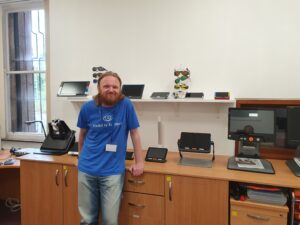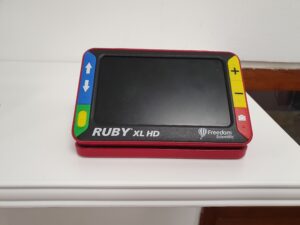Our Digital Advisor – Craig MacLagan – has written a blog to celebrate Disability Awareness Day.

Image ID: Craig wearing his blue Visibility Scotland t-shirt stands beside a table with information leaflets and a Visibility Scotland banner. Craig is smiling in the photo.
Craig looks at the technological advancements made since the first Disability Awareness Day back in 1992, and the challenges that remain in creating a truly accessible world for disabled people. Take it away, Craig!
Sunday 16 July 2023 is Disability Awareness Day (DAD).
The day is the brainchild of Dave Thompson, MBE DL , who is the founder and co-ordinator of the event. For the past 31 years, July 16th has been celebrated as a day to promote what is available to enable disabled people to live independently. Its main focus has always been “information”.
Since the inception of DAD in 1992, the world has changed for visually impaired people. And for the better. Back then, computers existed, sure. But accessibility? ZoomText was in its infancy, becoming available to Windows users just a year prior. JAWS (Job Access Speech) wouldn’t launch until 1995. And a “blog” wouldn’t enter our lexicon until two years after DAD became a thing.
So, in short, I’m really pleased to be sitting here in 2023 writing a blog for you about accessible and assistive technology – because there’s so much more information to share. And way more options at your disposal.
I’ve worked with Visibility Scotland for ten years and I’ve witnessed accessible technology evolve immensely. Digital magnifiers and devices with Optical Character Recognition (OCR) – that’s kit which will scan and read text back to you for the lay person – existed when I started. But they were big, bulky and expensive. And fairly primitive. Early versions of OCR devices were the perfect cure for insomnia, as the monotone, robotic voice would lull you to sleep. Now, there’s inflection, tone and context. Digital magnifiers came with a complimentary hernia, should you dare to move them from one room to another. Now, they can slide into your pocket or handbag and be there when you need it to check prices in the shops or keep on top of your mail.

Image ID: Ruby XL HD digital magnifier. It is a small, pocket-sized magnifier with large colourful easy-to-see and tactile buttons against the black face of the device; the handle and outer casing are ruby red.
Smartphones, tablets and apps have revolutionised accessibility features and made them available to the masses. Specialist assistive kit will always have its place, for crystal clear magnification and easy-to-use OCR. And for laptops and PCs, whether its built-in ‘Ease Of Access’ settings or specialist screen reading and magnification software, there are fewer barriers for visually impaired people. There’s still a learning curve and the frustrations of inaccessible websites – I’m sure you don’t need reminding that a recent survey of a million websites found 97.4% had accessibility issues on their home page. But we’re getting there. One step at a time. Raising awareness, sharing best practices and shouting from the rooftops about accessibility.
And that’s what I’d like you to do if you’re reading this blog. Become part of the solution. Play your part and share the link at the end of this article with a colleague, a friend or on social media.
I’m always startled at how little people are aware of accessibility features and functions. I don’t have enough fingers to count how many times I’ve had to explain how a visually impaired person can use a smartphone, or go online. It breaks my heart when I meet someone who left their job shortly after being diagnosed with an eye condition. Not because they could no longer do their role, but because they had no idea what is out there to help.
If you’re not too sure about what’s out there to help, or if you do know but don’t have large print and screen reader-friendly handouts to share this knowledge, then our website is jam-packed with resources and information about accessibility. Please check out the Shine On Access section of our website. Regardless of the kit you currently have, or your knowledge around what’s available, you’ll find details here on how to maximise the potential of your equipment. And in turn, how to maximise your own potential.
Shine on Access – Visibility Scotland – You don’t need sight to have vision.
Posted on the: July 13, 2023



 0141 332 4632
0141 332 4632


